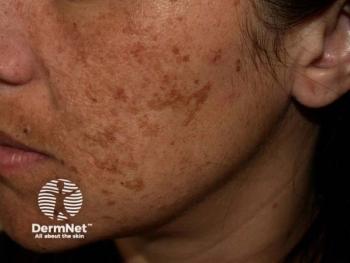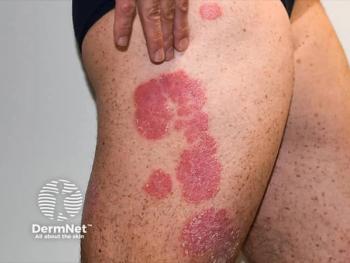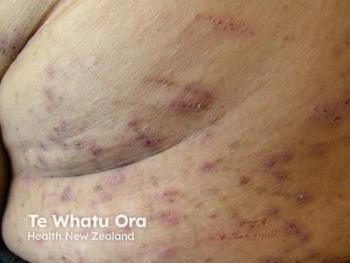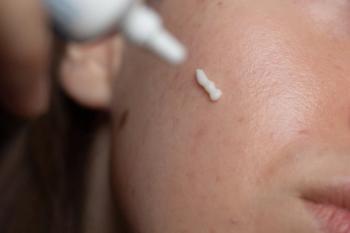
E-Learning Boosts OCT Training for BCC Detection
Key Takeaways
- OCT offers a non-invasive alternative to punch biopsy for BCC diagnosis, with comparable accuracy and reduced risks and costs.
- A CUSUM-integrated e-learning program effectively trains healthcare professionals in OCT-based BCC diagnosis, showing high specificity and subtyping accuracy.
E-learning enhances skin cancer detection by training professionals in optical coherence tomography (OCT) for accurate differentiation between basal cell carcinoma (BCC) and non-BCC lesions.
Although histopathological evaluation through punch biopsy remains the gold standard for basal cell carcinoma (BCC) diagnosis, it is invasive, time-consuming, and often unnecessary in lesions that can be reliably identified by noninvasive techniques.1 Optical coherence tomography (OCT), a light-based imaging modality capable of providing cross-sectional images of skin structures up to 1.5 mm in depth, is emerging as an alternative tool for BCC diagnosis. Recent studies have demonstrated that OCT can guide diagnosis and management, with comparable accuracy to biopsy-guided strategies, while minimizing procedural risks and cost.2
A pivotal randomized noninferiority trial showed that OCT-based assessment by experienced users had a sensitivity of 85.5% and specificity of 94.6% in detecting BCC, affirming its clinical utility in cases where diagnosis is uncertain.1 However, widespread clinical adoption is currently hampered by a shortage of trained OCT assessors and the absence of standardized training pathways. Addressing this gap, a recent study investigated the feasibility and effectiveness of a novel e-learning program integrated with cumulative sum (CUSUM) analysis to train health care professionals in OCT-based diagnosis of BCC.3
Development and Implementation
This digital training framework, developed by Maastricht University Medical Center+, included a theoretical module and practical exercises featuring 600 cases of histopathologically confirmed lesions. Trainees from 5 professional categories—dermatologists, residents, research physicians, nurses, and medical students—were instructed to evaluate OCT scans and corresponding lesion photographs and provide diagnostic confidence scores using a 5-point scale. CUSUM analysis continuously monitored performance, enabling trainees to visualize their diagnostic learning curve and determine when acceptable diagnostic accuracy was achieved and maintained.
Acceptable performance was defined as a diagnostic error rate of 16%, based on expert benchmarks, with an unacceptable rate of 25% reflecting clinical examination error. Trainees needed to demonstrate sustained acceptable performance across consecutive series of assessments to complete the training.
Training Outcomes and Diagnostic Performance
The researchers stated that 17 of 40 trainees successfully completed the program, requiring a median of 385 OCT evaluations and 11 hours of study. Sixteen of these novice assessors participated in a subsequent diagnostic accuracy study. When assessed on a new data set of 100 OCT scans of equivocal lesions (50 BCC and 50 non-BCC), the pooled area under the curve across all assessors was 0.852, indicating good diagnostic accuracy.
Novice assessors achieved high specificity (95.4%) for non-BCC lesions, an essential safety metric ensuring appropriate biopsy referral for non-BCC cases. However, the sensitivity for detecting BCC with high confidence was reported to be 31.1%, indicating that novice assessors were cautious in making a definitive diagnosis. When a slightly lower confidence threshold was accepted (score ≥ 3 instead of 4), the researchers stated that sensitivity improved to 58.8% with a modest drop in specificity to 91.5%.
For BCC subtyping, which is critical in determining appropriate treatment (eg, topical for superficial BCC vs excision for nodular/infiltrative BCC), the pooled sensitivity and specificity were 87.5% and 86.2%, respectively. Importantly, researchers found misclassification of aggressive subtypes as superficial was rare, suggesting the training sufficiently mitigates the risk of undertreatment.
Clinical Implications and Future Directions
The researchers stated that these results suggest that CUSUM-integrated e-learning is a promising tool for OCT training, offering scalability, performance monitoring, and the potential to alleviate reliance on in-person instruction. Although diagnostic confidence among novices was limited, their high specificity and subtyping accuracy support this training as a safe entry point into clinical OCT application. They noted that additional experience and supervision by experts may enhance sensitivity over time.
The study noted that a key advantage of this training model is its accessibility, as it allows remote, self-paced learning and real-time performance tracking. However, challenges remain: Only 17 of 40 participants completed training, underscoring potential barriers such as time constraints and motivation. Moreover, the artificial nature of the testing environment, which lacks the context of full clinical assessment, may limit generalizability.
Conclusion
CUSUM-integrated e-learning was found to be an effective, scalable approach to training health care professionals in differentiating BCC from non-BCC on OCT. Upon completion, researchers stated that novice assessors demonstrate high specificity (95.4%) and satisfactory performance in BCC subtyping. Although diagnostic confidence and sensitivity remain areas for growth, this training provides a safe and structured foundation for integrating OCT into clinical dermatologic practice. As OCT technology and access expand, the study stated that structured digital training may play a pivotal role in standardizing and optimizing noninvasive skin cancer diagnosis.
References
- Adan F, Nelemans PJ, Essers BAB, et al. Optical coherence tomography versus punch biopsy for diagnosis of basal cell carcinoma: a multicentre, randomised, non-inferiority trial. Lancet Oncol. 2022;23(8):1087-1096. doi:10.1016/S1470-2045(22)00347-3
- Welzel J. Optical coherence tomography in dermatology: a review. Skin Res Technol. 2001;7(1):1-9. doi:10.1034/j.1600-0846.2001.007001001.x
- Wolswijk T, Nelemans PJ, Adan F, et al. Cumulative sum analysis-integrated e-learning for differentiation between basal cell carcinoma and non-basal cell carcinoma on optical coherence tomography: an observational cohort study. Int J Dermatol. Published online June 27, 2025. doi:10.1111/ijd.17918
Newsletter
Like what you’re reading? Subscribe to Dermatology Times for weekly updates on therapies, innovations, and real-world practice tips.


















